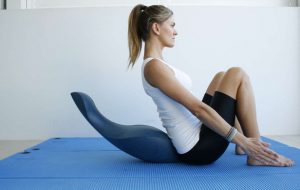What materials can help us to work our core? Technically all those involving the muscles of the central area of the body: from kettlebells to pulleys, to those that generate instability such as a foam roller or a fitball. But how many of these are specifically designed to work our core control? For this comes a new training material directly from Australia: the Oov.
It’s called Oov because it responds to the acronym of out vocabulary or without vocabulary, and at the same time you try it you realize the reason for that name. Simply when we are standing our body is always making small micro corrections in our posture automatically to keep us in the ideal position: the Oov does the same while we are working on it.
 What is Oov?
What is Oov?
Oov is a training material made with a patented swan-shaped microfoam (throwing it a little imagination). This microfoam is flexible and deformable, and gives us 50% of the pressure we exert on it, so it stays firm while working with Oov.
Its shape responds to that of our spine , offering us support in areas where we need to be lying on the ground or leaning against a wall, and its arched base is responsible for generating a certain instability that puts to work the entire Muscles of our core.
Oov is available in three sizes : small size, for people up to 1.70 meters, medium size for people up to 1.80 meters and large size for people over 1.80 meters. Not only must we take into account our height when choosing the ideal Oov for us, but also our complexion.
How do you work with Oov?
Oov is a very versatile material, since we can work with it in different positions : in prone and supine position, in lateral decubitus, in quadruped or directly standing on a wall. In its basic position we sit on the larger part of the Oov and we lean our back on the rest. In this way, the pelvis can move three-dimensional and the scapula are free to move in space.
The principles of training with Oov are four: the central control (from the musculature of the central part of the body – internal muscles of the abdomen – is from where we control our stability and all our movements), axial elongation (which helps us perform Diaphragmatic breathing and puts us in the safest position for movement), the mobilization of the hip (because, as we said, moves in the three dimensions, while with other implements we can only move it in two of them) and the mobilization Of the shoulders and the thoracic spine (the scapulae are free and we can move them in the space).
From these four principles we can work combining the Oov with Pilates exercises or with other implements such as therabands or balls, being always essential to maintain a neutral column position from which all movements start. It is also a great tool to evaluate clients, in the case that we are personal trainers, since from the first moment we can see the rectifications that make or the compensations of your body.
The experience of a class with Oov
I was able to enjoy a master-class of Oov with the companions of Polestar Pilates directed by Belén Sánchez, to try this new material and to experience firsthand how it works. The first thing you notice when you lay down on Oov is how your body constantly makes corrections to keep you in the right posture, without the teacher having to follow anything. The corrections are made by our own body automatically, and core muscles are in action all the time.
Once accustomed to being lying on the Oov we have started with some simple exercises of Pilates that, raised in this material, become a real challenge. This is another of the advantages of this material: it is very challenging and, like some exercises that can be seen assisted by the action of the Oov (like the roll-up, that leaves practically without thinking and without any effort), others They become much more difficult to perform on an unstable surface. A couple of times I rolled to the ground, I will not fool you, but once made a couple of adjustments by my own body, I was able to finish the exercises.
We work in all positions, even upside down (a bit uncomfortable until you find the ideal position) and quadruped, placing the Oov under one of our knees. After a one-hour session I ended up pretty tired, since it was a very intense session, but it is true that you can see the benefits in a very short time: you leave the session feeling activated and even with a greater mobility especially in the zone of the hip.
